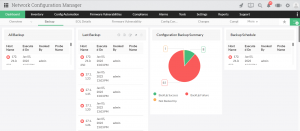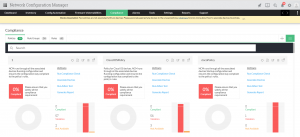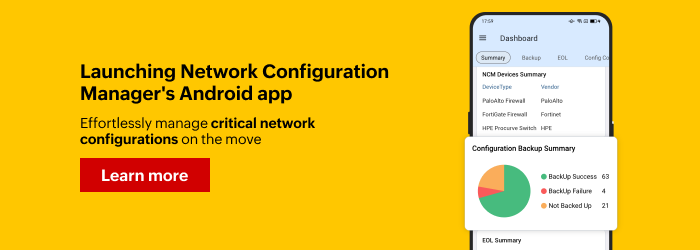
“Automation applied to an inefficient operation will magnify the inefficiency.” – Bill Gates
A network, as we all know, is the connection of multiple devices to share information between them. While it’s a major task to manually manage every device connected to a network, a software-based feature called network automation can be utilized to help overcome this challenge. Network automation can be used to automate tasks so the workload and any human errors are greatly minimized.

Networks work based on orchestration, or network orchestration. Network orchestration is a policy-driven approach to network automation that coordinates the hardware and software components a software application or service requires to run, and it’s used to reduce the human intervention required for major tasks. Network orchestration components include configuration, policies, automation, applications, and management.
This network orchestration is handled seamlessly via automation using a network automation tool. In this blog, the network automation tool we’ll be referring to is ManageEngine Network Configuration Manager.
Why does configuration or any of the above-mentioned components need to be managed using a network automation solutions?
The answer is simple.
- Misconfigurations are the leading cause of network incidents around the world. Configuration management keeps you from making small or large changes that go undocumented. Using Network Configuration Manager, you can monitor the configurations in your network to prevent misconfigurations. Misconfigurations can lead to network outages, poor performance, inconsistencies, noncompliance, and loss of access to a particular subnet or a network, which negatively impact business operations and security.
Identifying network devices that require attention, determining remediation steps, prioritizing actions, and validating completion are too complicated to perform manually in large environments. But without documentation, maintenance, and a change control process, network administrators and operators may end up not knowing what’s on a server or which software has been updated. With Network Configuration Manager, you get complete visibility into your network configurations, all from a single console. -
Policies help devices in the network stay compliant with organizational rules, but it’s difficult to check each device’s policy one by one in a large network. Network Configuration Manager has a built-in feature to check for compliance as well as a feature that enables you to create your own policies for devices.
-
Performing tasks manually is tedious for admins and operators. Using Network Configuration Manager, you can automate any task in just a click and also generate one-line commands for a network of 1,000 to 10,000 devices. In addition, instead of manually troubleshooting devices on-premises or one by one, you can simply log in to Network Configuration Manager, select the device that needs troubleshooting, and solve the issue from the comfort of your own office or home.
-
Good management is important in maintaining a well-functioning network. All devices should be managed by automation so when a human isn’t around, the tool itself takes care of all processes and generates reports. Network Configuration Manager provides this advantage.
Current challenges in automating networks using network automation tools
Network automation tools aren’t without their challenges. Some of these challenges are listed below:
- Some network vendors don’t provide customization options or an option to add multiple vendors, making it harder to use the tools in the first place
- For network engineers to use these tools, they often need to learn new things such as coding or scripting, which may be difficult.
- Some traditional network vendors have never used automation so they must implement it carefully, keeping in mind the disparate commands and procedures between different automation solutions.
- APIs, which are important for automation, are still lacking and in development.
- If there are no compliance standards or if vendors are new to automation and have to follow new compliance standards, there may be deviations in how the tools are implemented, which can lead to major network issues. Some network automation services are, by default, not automation-friendly, either.
These challenges are greatly minimized when using Network Configuration Manager.
Key features that a network automation tool should have
-
Manages mundane tasks without human intervention
-
Performs repetitive tasks and isn’t interrupted when a single task is performed at the same time
-
Contains a built-in automation feature to complete tasks in bulk, such as changing the passwords of 5,000 devices or enabling SNMP in all devices
-
Logs all actions so events can be reviewed after unattended processes have been completed
-
Can be scheduled to run regularly outside of office hours so all operations are performed when users are away and reports are provided the next day
A brief overview of Network Configuration Manager, an all-in-one network automation platform
Network Configuration Manager is a network automation software that supports multiple vendors for various operations such as change management, configuration backups, and compliance management for switches, routers, firewalls, and other network devices. Network Configuration Manager provides full automation and helps you take total control of the entire device configuration management life cycle. Some of the vendors supported include Cisco, NetGear, Fortinet, Juniper, and HP.
Features
Backup configuration management
Making a backup of the network configurations is essential for future use in case downtime occurs. With Network Configuration Manager’s backup feature, you can perform automated, manual, or scheduled backups according to your needs.

Change management
Network Configuration Manager uses real-time change detection to alert you immediately if a change is made and if the change is authorized or unauthorized. It also has a role-based access control feature where admins have full authority and any changes have to be approved by them.

Network automation using Configlets
Configlets in Network Configuration Manager are a set of command templates used for multiple purposes and multiple devices. Using Configlets, you can add passwords for 10,000 devices or enable or disable SNMP for devices in bulk, saving time and effort. They’re mainly used for troubleshooting multiple devices at once.

Compliance management
Compliance rules set the standards for a network device to follow so that no major data leak or any other major situation occurs. Common policies include Cisco IOS, PCI, SOX, and HIPAA.
If devices are non-compliant, then Network Configuration Manager labels them as a Critical violation, Major violation, or Warning violation, depending on the device. Here, Configlets can also be used for remedial purposes.
Network Configuration Manager also allows you to create rules and policies on your own and apply them to devices.

Firmware vulnerability management
Firmware is a specific class of computer software that provides low-level control for a device’s specific hardware. Since firmware is in constant danger from malicious attacks, Network Configuration Manager analyzes it for any threats. If a threat is detected, the tool creates a report with a CVE ID (vulnerability ID), with which you can identify what the risk is for the device using a base score.

Price: Click here to view our store for detailed pricing-related information. Click here to get a pricing quote.
Download: Download the free, 30-day trial of Network Configuration Manager, and start automating your network configuration management.

